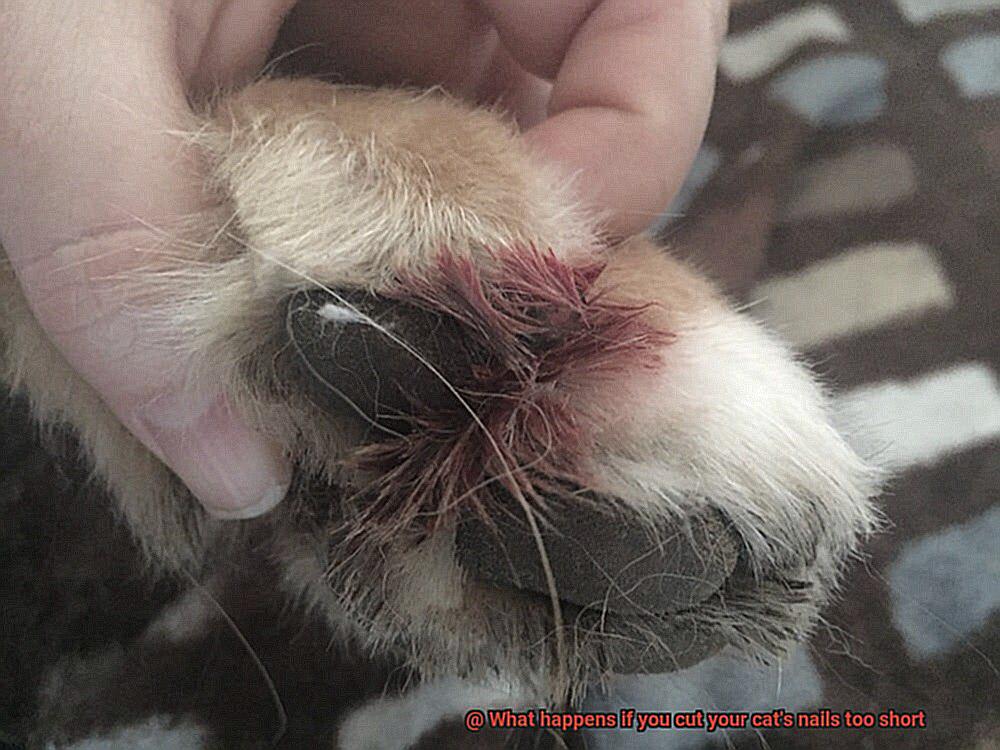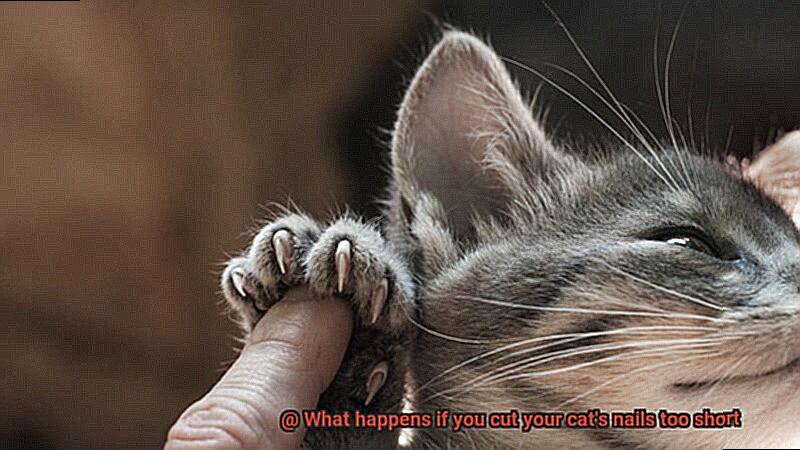Keeping your cat’s nails trimmed is a crucial part of their grooming routine. It not only helps maintain their health but also prevents them from damaging your furniture. However, the process can go wrong if you accidentally cut your cat’s nails too short. The result? A painful yelp from your furry friend and a feeling of guilt that can last for days.
The main reason for over-trimming is the inability to see the quick, which is the pink area that houses blood vessels and nerves. If you clip it too short, it can cause a painful bleeding injury that may require veterinary attention in severe cases. Over-trimming can also lead to discomfort, infection, and fear of nail trimmings in your cat.
If you accidentally cut your cat’s nails too short, don’t panic. The bleeding may stop on its own, but if it doesn’t, apply pressure on the affected area and seek veterinary help if necessary. Your cat may also experience pain and discomfort that can cause limping and an altered posture.
Don’t let this incident discourage you from trimming your cat’s nails in the future. Instead, learn from your mistake and take precautions to prevent it from happening again. Ensure that you have enough lighting to see the quick clearly before clipping their nails. Also, provide your feline companion with treats and reassurance throughout the process to keep them calm.
In conclusion, cutting your cat’s nails too short can be a painful experience for both you and your furry friend. But with proper precautions and care during the process, you can safely trim their nails without causing any physical or emotional harm to them.
What Happens When You Cut Your Cat’s Nails Too Short?
Cutting your cat’s nails too short can lead to a range of problems that can be detrimental to their physical and emotional wellbeing.
The quick of the nail, which contains blood vessels and nerves, runs through the nail. If you accidentally cut into the quick while trimming your cat’s nails, it can cause pain, bleeding, and even infection if not treated correctly. To avoid this, use high-quality clippers specifically designed for cats and trim small amounts at a time.
Aside from the physical discomfort caused by cutting your cat’s nails too short, it can also lead to behavioral issues. Cats rely on their claws for activities such as marking their territory or climbing up high places. If their nails are painful or uncomfortable due to being cut too short, they may stop using them altogether, leading to a lack of exercise and potential weight gain.
Moreover, cutting your cat’s nails too short can create a reluctance to have their nails trimmed in the future. If your cat experiences pain or discomfort during a nail trimming session, they may become fearful or anxious about the process and resist any attempts to trim their nails in the future. This can make it even more challenging to keep your cat’s nails healthy and hygienic.
To prevent these issues from occurring, take it slow, and only trim small bits at a time. If you do accidentally cut your cat’s nails too short, remain calm and apply pressure with a clean cloth or paper towel to stop the bleeding. You can also use styptic powder or pencil to coagulate the blood and stop the bleeding.

Potential Signs of Pain and Bleeding
Despite your best efforts, it is possible to accidentally cut your cat’s nails too short, causing discomfort and potential bleeding. Knowing what to look for can help you take prompt and appropriate action to relieve your cat’s discomfort.
Limping or favoring one paw over the other is one of the earliest signs of pain. Walking on the affected paw may cause discomfort, making it difficult for your cat to move around comfortably. Meowing or hissing is another sign that your cat is in pain. These vocalizations are their way of communicating their discomfort to you, so don’t ignore them.
Bleeding from the nail is a common symptom when you cut a cat’s nails too short. Although it may be frightening to see blood, it’s important not to panic. Applying firm pressure with a clean cloth or tissue can help stop the bleeding. If the bleeding persists for more than a few minutes, contact your veterinarian for advice.
Other signs of pain and discomfort include licking or biting at the paw, swelling around the nail, and reluctance to walk or play. These symptoms could indicate an infection or other complication resulting from the nail being cut too short. Keep an eye out for these signs and take prompt action if they occur.
To avoid causing pain and bleeding when cutting your cat’s nails, go slowly, use sharp clippers specifically designed for cats, and never cut into the quick (the pink part inside the nail). By taking these precautions, you can minimize the risk of causing discomfort to your furry friend.
How to Stop the Bleeding
Cutting your cat’s nails can be an important part of their grooming routine, but it’s crucial to be careful not to cut them too short. Accidentally cutting a cat’s nail too short can cause pain and bleeding, which can be a stressful experience for both you and your furry friend. Luckily, there are steps you can take to stop the bleeding and help your cat feel more comfortable.

Stay Calm
The first step in stopping the bleeding is to remain calm. Cats can sense our emotions, and if we are anxious or panicked, it can cause them to become more stressed and agitated. Taking a deep breath and approaching your cat with a calm and soothing voice can help keep them still and relaxed.
Apply Pressure
Next, you will need to apply pressure to the affected nail. It’s important to use a clean cloth or tissue to avoid introducing any bacteria into the wound. Apply firm pressure for several minutes until the bleeding slows or stops.
Use Styptic Powder or Pen
If the bleeding does not stop after several minutes of pressure, you may need to use a styptic powder or pen. These products contain ingredients such as silver nitrate or ferric subsulfate that help to clot the blood and stop the bleeding. You can apply the powder directly onto the affected area or use a cotton swab to dab it on. Hold it there for several seconds until the bleeding stops.

It’s important to note that styptic powders and pens can be painful for your cat, so it’s best to avoid using them unless absolutely necessary. If you do use one of these products, make sure to provide your cat with plenty of love and comfort afterwards.
Check for Infection
After you have stopped the bleeding, keep an eye on your cat’s nail for any signs of infection. If you notice redness, swelling, or discharge, contact your veterinarian immediately. They may prescribe antibiotics or other medications to treat the infection and prevent further complications.
Prevention
To avoid cutting your cat’s nails too short in the future, be sure to use sharp and appropriate nail clippers designed specifically for cats. Take it slow and only trim small bits at a time. If you’re unsure about where the quick is located, it’s better to err on the side of caution and trim less of the nail. Consistently trimming your cat’s nails can also help prevent them from becoming overgrown and causing discomfort.
When to Seek Veterinary Care
Don’t worry. However, it’s important to know when it’s necessary to seek veterinary care.
If you notice bleeding after a nail trim, apply pressure to the affected area with a clean cloth or tissue. You can also dip their paw in flour or cornstarch to help clot the blood. But if you see excessive bleeding or your cat seems to be in pain or discomfort, don’t hesitate to seek immediate veterinary care.
Cutting your cat’s nails too short can lead to infection if not treated correctly. If you observe swelling, redness, or discharge after a nail trim, it’s critical to seek veterinary care as soon as possible. Your vet can prescribe antibiotics or other medications to treat the infection and prevent any further complications.
Here are some essential points to keep in mind when seeking veterinary care after cutting your cat’s nails too short:
- If your cat displays excessive bleeding or seems to be in a lot of pain or discomfort, seek immediate veterinary care.
- If you notice any signs of infection after a nail trim, such as swelling, redness, or discharge, it’s important to seek veterinary care as soon as possible.
- Monitor your cat closely after a nail trim and seek veterinary care if you notice any signs of discomfort or bleeding.
Tips for Avoiding Accidents in the Future
Trimming your cat’s nails can be a tricky task, and accidents can happen, especially if you are not well-equipped or knowledgeable about the process. However, with the right tools and techniques, you can avoid accidents and ensure that your cat’s nails remain healthy and comfortable. Here are some tips to help you avoid accidents when trimming your cat’s nails in the future.
Choose the right tools
Invest in high-quality nail clippers specifically designed for cats. Using dull or inappropriate clippers can cause pain, discomfort, or even damage to your cat’s nails. A good pair of clippers will allow you to make clean cuts without crushing the nail or causing any pain to your cat.
Understand your cat’s nail anatomy
The quick, which contains blood vessels and nerves, is located in the center of the nail. Cutting into the quick can cause bleeding and pain. To avoid this, trim a small portion of the nail at a time and stop when you see a pinkish or grayish oval shape appear in the center of the nail. This will ensure that you do not cut into the quick and hurt your cat.
Get your cat comfortable with paw handling
Cats can be sensitive about their paws being touched, so getting them used to it is essential before attempting to trim their nails. Gently massage and play with their paws during playtime or while they are relaxed on your lap. This will get them used to having their paws touched and make nail trimming less stressful for both you and your cat.
Take breaks if needed
Trimming your cat’s nails can be a time-consuming process, so if your cat is getting agitated or squirming, take a break and come back to it later. You don’t want to rush the process and risk injuring your cat.
Seek professional advice if unsure
If you are unsure about how to cut your cat’s nails or if your cat has dark-colored nails making it difficult to see the quick, consider seeking advice from a veterinarian or professional groomer. They will have the expertise and experience to safely trim your cat’s nails without causing any harm.
Proper Tools for Trimming Cat Nails
The process can be daunting and stressful for both you and your cat. That’s why it’s crucial to use the proper tools when trimming cat nails to ensure that the experience is safe, efficient, and stress-free.
One of the most essential tools for trimming cat nails is nail clippers. There are two types: scissor clippers and guillotine clippers. Scissor clippers work best for cats with thick nails, while guillotine clippers are suitable for cats with delicate nails. To avoid any discomfort or pain, it’s crucial to choose the right size of clippers for your cat’s nails. Using clippers that are too small can cause discomfort, while using clippers that are too large can crush the nail.
In addition to nail clippers, a nail grinder can also be a helpful tool in trimming your cat’s nails. Nail grinders work by filing down the nail instead of cutting it off, making them ideal for cats with thick nails or if you want to smooth out rough edges after clipping. When using a nail grinder, start slowly and avoid over-filing to prevent damage to your cat’s nails.
Lastly, styptic powder is a must-have tool for every cat owner. Accidents happen, and in case you accidentally cut the nail too short and hit the quick, styptic powder is used to stop bleeding immediately by forming a clotting agent when applied to the bleeding area.
Taking it Slow is Key
The thought of cutting them can be daunting. That’s why it’s crucial to take it slow and approach the task with patience and care.
Cutting your cat’s nails too short can lead to immediate pain and discomfort, as well as long-term issues. The quick, which is the pink part of the nail containing blood vessels and nerves, can become exposed and infected. This can cause your cat to be hesitant to let you cut their nails in the future, making the process even more challenging.
To avoid these problems, follow these tips:
- Use the right tools: Make sure you have sharp nail clippers or a grinder designed specifically for cats. Dull or inappropriate tools can make the process more difficult and painful for your cat.
- Choose the correct size: Select clippers or a grinder that match your cat’s nail size. Using the wrong size can lead to uneven cuts or accidentally hitting the quick.
- Have styptic powder on hand: In case you do accidentally cut the quick, having styptic powder nearby can help stop any bleeding.
- Shine a light: If you’re not sure where the quick is located, use a flashlight to shine through the nail and locate it before making any cuts.
Know Where the Quick is Located
Trimming your cat’s nails can be a daunting task, especially if you’re not familiar with the anatomy of their paws. One of the most important things to learn is where the quick is located and how to avoid it when cutting your cat’s nails.
The quick is the pink part of your cat’s nail that contains blood vessels and nerves. Accidentally cutting into the quick can cause pain and bleeding, which can be distressing for your cat. Therefore, it’s crucial to identify the location of the quick before starting to trim your cat’s nails.
If your cat has light-colored nails, you should be able to see the pink area of the nail through the translucent outer layer. This will give you an idea of where the quick is located, allowing you to trim their nails confidently. However, if your cat has dark-colored nails, it can be more challenging to see where the quick is. In this case, we recommend making small cuts at a time and avoiding cutting too close to the base of the nail.
Another helpful tip for locating the quick on dark-colored nails is to use a flashlight to shine through the nail. This will give you a better view of the blood vessels and nerves running through the nail and help you avoid cutting into them.
It’s important to remember that cutting your cat’s nails too short can cause more than just pain and bleeding. It can also lead to infections or even permanent damage to the nail bed. Therefore, it’s crucial to take your time and be careful when trimming their nails.
Conclusion
Trimming your feline’s nails is a crucial aspect of their grooming routine. However, accidents can happen, and if you cut their nails too short, it can lead to excruciating pain, discomfort, bleeding, and potential infections. To avoid such mishaps, it is essential to understand the anatomy of your cat’s nails and take necessary precautions when trimming them.
Identifying the quick in your cat’s nail before cutting is vital. The quick contains blood vessels and nerves and appears as a pinkish or grayish oval shape at the center of the nail. Cutting into the quick can cause immense pain and bleeding, so it’s crucial to avoid it at all costs.
If you accidentally trim your cat’s nails too short, don’t hit the panic button yet. Apply pressure with a clean cloth or tissue to stop any bleeding. You can also use styptic powder or pencil to help coagulate the blood. Keep a close eye on your furry friend for signs of infection or discomfort.
To prevent future accidents from happening again, choose high-quality clippers designed explicitly for cats and take things slow by trimming small amounts at a time. If you’re unsure about where the quick is located, use a flashlight to shine through the nail.
Remember that cutting your cat’s nails too short can lead to behavioral issues such as fear of nail trimmings or lack of exercise due to discomfort. Therefore, approach this task with care and seek veterinary advice if necessary.







